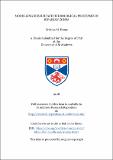Modelling subsurface hydrological processes in riparian zones
Abstract
Soil moisture is a crucial but unseen component of the hydrologic cycle. It provides a hydrologic link
and storage between surface waters and groundwater. This unexposed water sanctuary could be the key to
sustain life during ever-prevalent climatic extremes. To quantify and understand the role of soil moisture in
catchment hydrology, the HaughFlow model has been developed as a new tool to simulate subsurface
hydrology and water flow in floodplain soils. The model is constructed to be flexible, adaptable and
logically composed in order to encourage interaction from the wider scientific community. Model transparency
and parsimony are key; with assumptions clearly explained and only the dominant processes simulated
to limit the number of inputs required and retain efficiency. The dominant processes for hydraulically
connected floodplains comprise lateral saturated flow, driven by river-stage fluctuations, and vertical unsaturated
flow, driven by precipitation and evapotranspiration.
HaughFlow is applied to study sites in Australia and Germany with distinct climate conditions to
exhibit the model’s range of applicability. The lateral and vertical components of the model are calibrated
and evaluated in detail to determine the accuracy of model outputs. Evaluation methods (i.e. graphical
comparison, standard regression, Nash-Sutcliffe efficiency and percentage bias) are used to suggest best
practice for model calibration and the best outputs are then used to establish dominant trends in subsurface
hydrology at each site; including climatic changes and the long-term effects of drought periods.
Oxygen and hydrogen isotope tracers are also incorporated into the model, allowing the user to decouple
the intermixed contributions from lateral and vertical processes in the soil. Observed precipitation and river
isotope inputs can be used to predict actual isotope fractionation and mixing patterns in the soil. Using
artificial isotope inputs, however, can be used to clearly delineate the capillary fringe and water plumes
from individual rainfall events, within the soil. Hence, HaughFlow is a powerful numerical tool that can be
used to establish hydrologic trends and their drivers in the soil, to understand the role of soil moisture in
the hydrologic cycle. Ultimately these outputs can be used to investigate key questions in vegetative water
sourcing and how plants adapt to changes in water availability.
Type
Thesis, PhD Doctor of Philosophy
Collections
Items in the St Andrews Research Repository are protected by copyright, with all rights reserved, unless otherwise indicated.

